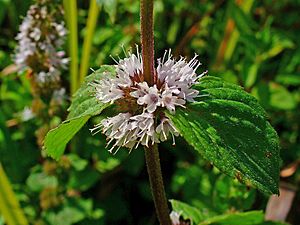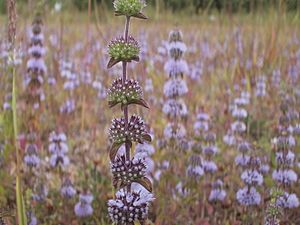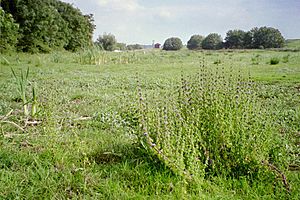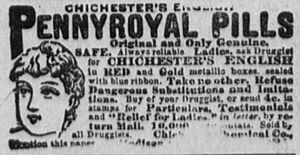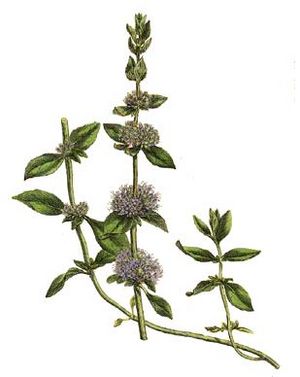Mosquito plant facts for kids
Quick facts for kids Mosquito plant |
|
|---|---|
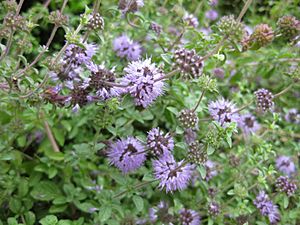 |
|
| Scientific classification | |
| Genus: |
Mentha
|
| Species: |
pulegium
|
Mentha pulegium, also known as European pennyroyal or just pennyroyal, is a type of flowering plant that belongs to the mint family. It grows naturally in places like Europe, North Africa, and the Middle East. If you crush its leaves, they release a very strong smell, similar to spearmint. In the past, people used pennyroyal as a traditional remedy and in cooking. However, it's important to know that it can be harmful to the liver and has caused serious health issues for some people.
Contents
What Does Pennyroyal Look Like?
Pennyroyal can be an annual plant, meaning it lives for just one year, or a perennial plant, which means it lives for many years. Its stems can either creep along the ground or stand straight up, reaching about 40 centimeters (16 inches) tall. The stems are square-shaped and can be smooth or very hairy. They are usually green, but sometimes they might be red or purple.
The leaves grow in pairs opposite each other. They are shaped like narrow ovals, about 2–3 cm (1 inch) long and 1 cm (0.4 inches) wide. They feel soft and have a few small teeth near their tips. All parts of the plant have a very strong smell when you crush them.
The small flowers are about 6 millimeters (0.2 inches) wide. They grow in tight groups around the stem, with leaf-like parts called bracts underneath them. Each flower has four purple "petals" and four long parts called stamens that stick out. After the plant flowers, it produces tiny, brown, one-seeded fruits.
Pennyroyal usually flowers from June through the middle of summer. In cooler northern areas, it might flower later, sometimes even in September.
Where Can You Find Pennyroyal?
Pennyroyal is believed to have first grown around the eastern Mediterranean Sea. It likes to grow in wet meadows, near ponds, and along the edges of streams. However, it has now spread all over the world! You can find it in North and South America, Africa, Asia, Australia, and New Zealand.
In many places, people consider it a bothersome weed on farms. In some northern areas, like Britain, it is becoming rare.
Where Does Pennyroyal Live?
Pennyroyal loves places that are wet for part of the year, such as pastures that get damp in spring. It grows well in areas where standing water in winter leaves bare ground in summer. It also thrives along roadsides where the ground is disturbed, especially if it gets very wet in winter. You can also find it along rivers, in wet woods, and in fields that are no longer farmed.
In California, it is seen as an invasive species. This means it spreads easily and might take over areas where native plants used to grow. It lives in similar wet spots there, like streamsides and wet ditches.
Not many animals eat pennyroyal. In Britain, only one type of bug, called Heterogaster artemisiae, is known to feed on it. This bug usually eats wild thyme.
History of Pennyroyal
How Was Pennyroyal Used Long Ago?
People have used pennyroyal for a very long time, going back to ancient Greek, Roman, and Medieval times. Its name is thought to come from the Latin word pulex, which means "flea." This is because people used to rub the plant on themselves to keep fleas away.
The Greeks and Romans often used pennyroyal as a cooking herb. Many recipes in an old Roman cookbook by Apicius included pennyroyal, often with other herbs like lovage and oregano. Even though it was used in cooking during the Middle Ages, it is rarely used in food today.
Ancient doctors and scholars wrote about pennyroyal's uses in medicine and how to prepare it.
Early settlers in colonial Virginia used dried pennyroyal to get rid of pests. It was so popular that the Royal Society even published an article about its use against rattlesnakes in 1665. A famous 17th-century doctor named Nicholas Culpeper wrote about pennyroyal in his book The English Physitian in 1652. He suggested using it for stomach problems, itching skin, and even toothaches.
Pennyroyal is still an important ingredient in a North African dish called Batata fliou.
People continued to use pennyroyal into the 20th and 21st centuries. Its oil is still sold today, but we don't know exactly how much is safe for humans to use. Because of this, scientists generally think it's not safe to use, as it can be harmful.
How Is Pennyroyal Used Today?
Pennyroyal is often used to keep insects away. People use it to keep fleas off pets and to stop gnats and mosquitoes from biting humans. Some flea collars for pets have pennyroyal oil, or the crushed herb can be put in the collar's lining. People have also put crushed pennyroyal stems in their pockets or on their clothes to keep bugs away.
However, it is very important to avoid using concentrated pennyroyal oil. This oil can be extremely harmful to both humans and animals, even in small amounts. It can be absorbed through the skin and cause serious health problems. It's much safer to use the less concentrated leaves of the plant as an insect repellent.
Historically, pennyroyal was also used to flavor herbal teas and foods. Pennyroyal tea was used for colds, fevers, coughs, stomach problems, and headaches. The fresh or dried leaves were also used for the flu and to make people sweat. To make the tea, the leaves are boiled in hot water. The amount of harmful chemicals in these teas is much lower than in the oil. However, it's recommended to drink pennyroyal tea only sometimes, as it can still be hard on the body. It should never be given to babies or young children, as it can be very dangerous for them.
In Italy, the fresh leaves of this plant, called menta romana in Rome, are used in cooking to flavor lamb and tripe.
One study has shown that pennyroyal oil can kill house dust mites.
Is Pennyroyal Harmful?
Yes, pennyroyal can be harmful to humans. How it affects you depends on how much you take and how strong it is. The most harmful form is pennyroyal oil. This oil contains a lot of a chemical called pulegone (80% to 92%). Pulegone is what gives the plant its minty flavor, but it also causes many health problems if swallowed.
If you take a small amount of pennyroyal oil (less than 10 milliliters), you might feel sick, throw up, have stomach pain, and feel dizzy. Larger amounts can cause many organs to fail, which can lead to death.
Scientists have studied how pulegone affects animals. When pulegone is swallowed, the liver breaks it down into other chemicals that can harm the body. These harmful chemicals can damage the liver and kidneys.
Images for kids
See also
 In Spanish: Mentha pulegium para niños
In Spanish: Mentha pulegium para niños


